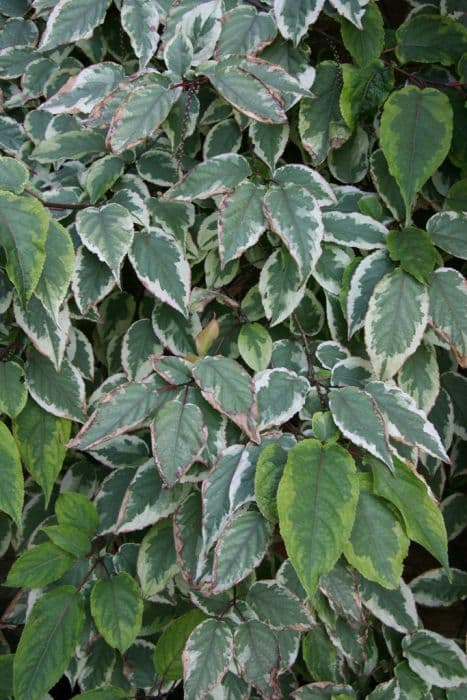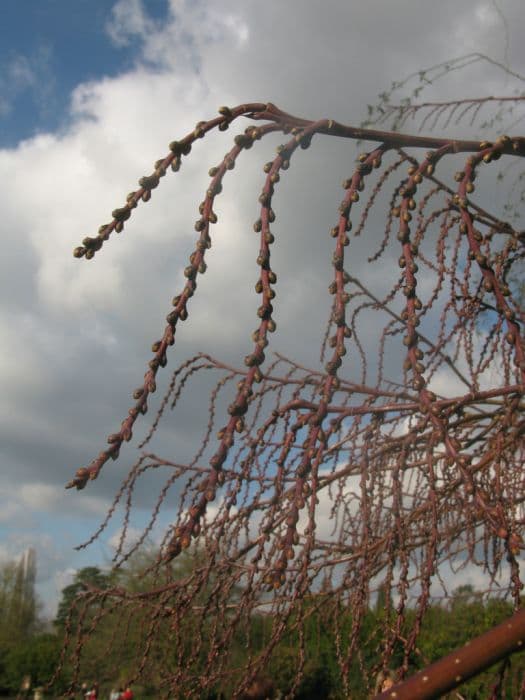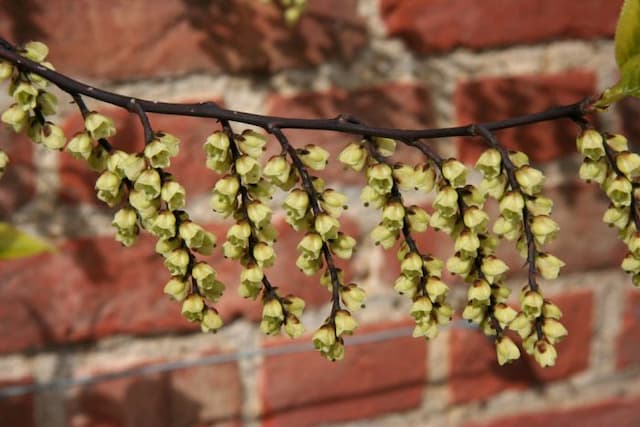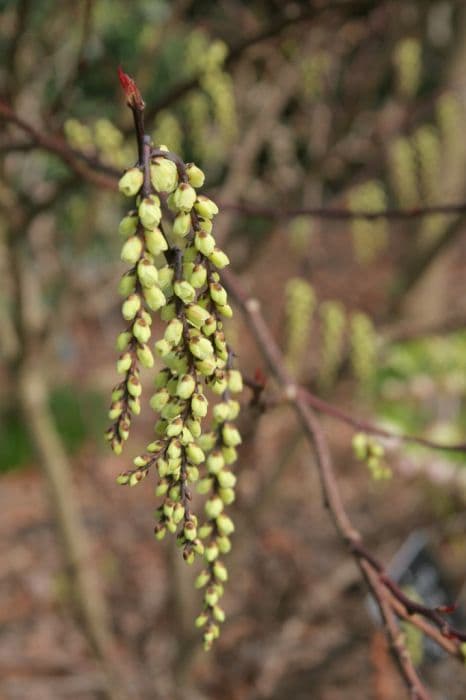Spiketail Stachyurus praecox

ABOUT
The spiketail is an ornamental shrub known for its striking early spring display. This decidarous shrub features long, drooping, chain-like clusters of small yellow flowers that appear before the leaves. These clusters can give a spectacular show when most other plants are still dormant. After the flowering period, the spiketail showcases bright green leaves that are elongated and slightly serrated at the edges. These leaves turn to attractive shades of yellow before they fall in autumn. The bark of the spiketail is notable for peeling off in fine strips, revealing an interesting texture on the mature stems. The spiketail, with its cascading flowers and vibrant leaves, is a unique addition to any garden that seeks to have early flowering plants.
About this plant
 Names
NamesFamily
Stachyuraceae
Synonyms
Spiketail, Early Stachyurus
Common names
Stachyurus praecox.
 Toxicity
ToxicityTo humans
Stachyurus praecox, commonly known as the Spiketail, is not widely recognized for being toxic to humans, and there are no well-documented cases of poisoning from this plant. There is limited information on its toxicity, but it is always advisable to avoid ingesting parts of ornamental plants due to potential unknown risks. If you suspect poisoning from any plant, it is important to seek medical attention immediately.
To pets
Spiketail is not widely known to be toxic to pets either. Like with humans, there is limited information available regarding its toxicity to animals. However, as a general precaution, it's always best to prevent pets from ingesting plants not meant for consumption. If you suspect your pet has ingested Spiketail, or if they exhibit unusual symptoms, contacting a veterinarian as soon as possible is recommended.
 Characteristics
CharacteristicsLife cycle
Perennials
Foliage type
Deciduous
Color of leaves
Green
Flower color
Yellow
Height
6-10 feet (1.8-3 meters)
Spread
4-8 feet (1.2-2.4 meters)
Plant type
Shrub
Hardiness zones
5
Native area
Japan
Benefits
 General Benefits
General Benefits- Ornamental Appeal: Stachyurus praecox, commonly known as the spike-tail, provides visual interest with its unique cascading racemes of yellow flowers appearing in early spring before the leaves.
- Landscape Use: The spike-tail can serve as a focal point in gardens due to its attractive appearance and distinctive flowering habit.
- Wildlife Support: The flowers of the spike-tail can attract pollinators such as bees, providing them with an early spring nectar source.
- Seasonal Interest: This plant adds early seasonal interest to landscapes, as it is one of the first shrubs to bloom in late winter or early spring.
- Low Maintenance: The spike-tail tends to require minimal maintenance once established, thus it is suitable for gardeners who prefer low-care landscape plants.
- Cultural Significance: In some cultures, the spike-tail is appreciated for its early blooms and is associated with the coming of spring, symbolizing renewal and growth.
- Companion Planting: It can be paired with late-flowering plants to extend the blooming season in gardens.
 Medical Properties
Medical PropertiesThis plant is not used for medical purposes.
 Air-purifying Qualities
Air-purifying QualitiesThis plant is not specifically known for air purifying qualities.
 Other Uses
Other Uses- Floral Arrangements: The delicate, hanging flowers of Stachyurus praecox, also known as Spiketail, can be cut and used in floral arrangements, providing a unique texture and shape that adds visual interest.
- Artistic Inspiration: Due to its unique appearance, Spiketail can serve as inspiration for artists and designers, particularly in the spring when it showcases its vibrant yellow blooms.
- Garden Theming: Spiketail can be used in Japanese-themed gardens to enhance the authenticity and ambiance, as it is native to Japan and enhances the feeling of an Eastern-style garden.
- Bird Attraction: The plant can draw in a variety of birds, serving as a natural bird attractant due to the shelter it provides and potentially the insects it may harbor in its foliage.
- Education and Research: Spiketail can be used in educational settings such as botanic gardens or conservation areas to teach about plant growth patterns and seasonal changes.
- Photographic Subject: Garden photographers might use the unique flowering patterns of Spiketail as a compelling subject for botanical photography, especially in early spring.
- Leaf Castings: The textured leaves of Spiketail can be used to make decorative leaf castings for garden art or crafts, capturing the detailed vein patterns in a plaster or cement medium.
- Bonsai Practice: While not a traditional bonsai plant, Spiketail can be experimented with by bonsai enthusiasts to create a bonsai specimen due to its interesting structure and foliage.
- Privacy Screen: When grown in groups or as a hedge, Spiketail can provide a natural privacy screen in the garden during the growing season.
- Seasonal Celebrations: In areas where Spiketail naturally blooms, its flowering can be used to mark the changing of the seasons and could be incorporated into local festivals or traditions.
Interesting Facts
 Feng Shui
Feng ShuiThe Stachyurus praecox, commonly known as the Spike-tail, is not used in Feng Shui practice.
 Zodiac Sign Compitability
Zodiac Sign CompitabilityThe Spike-tail is not used in astrology practice.
 Plant Symbolism
Plant Symbolism- Renewal: Stachyurus praecox, commonly known as the Spiketail, blooms in early spring, symbolizing the beginning of a new cycle and the waking of nature from winter's dormancy.
- Hope: The early flowers of the Spiketail represent hope and the promise of better times as the first signs of spring appear.
- Change: With its early blooming cycle, the Spiketail signifies change and the inevitable shift of the seasons, reminding us of the transient nature of life.
 Water
WaterThe Spiketail (Stachyurus praecox) prefers consistent moisture, especially during its growing season in the spring and summer. It is crucial to avoid letting the soil dry out completely, but be cautious not to overwater and cause waterlogging. Water the Spiketail once a week with about 1 to 2 gallons, depending on the weather conditions and soil drainage. Decrease watering frequency to every two weeks in the fall and winter when the plant is dormant. Adjust the amount and frequency based on rainfall and temperature, ensuring the soil remains evenly moist but not saturated.
 Light
LightSpiketail thrives best in partial shade to full sun exposure. It should be placed in a spot where it receives morning sun and afternoon shade, or dappled sunlight throughout the day. An ideal location would provide protection from the harsh midday sun, which can scorch the leaves, while still giving it enough light to encourage healthy growth.
 Temperature
TemperatureSpiketail does well in a wide range of temperatures but prefers a moderate climate. The ideal temperature range for its growth is between 60 to 75 degrees Fahrenheit. The plant can withstand minimum temperatures as low as 20 degrees Fahrenheit, making it suitable for growing in regions with cooler climates. However, it is not tolerant of extreme heat, so it should be sheltered from temperatures above 85 degrees Fahrenheit.
 Pruning
PruningPrune the Spiketail primarily to maintain shape and remove any damaged or dead wood. The best time for pruning is in late winter or early spring before new growth starts. Pruning can be done annually to encourage a tidy habit and to promote vigorous growth. Occasional thinning may also be beneficial to provide air circulation within the canopy.
 Cleaning
CleaningAs needed
 Soil
SoilFor Spike-tail, mix well-draining soil with organic matter; peat moss and perlite can improve structure. The soil pH should be acidic to neutral, ranging from 5.5 to 7.0.
 Repotting
RepottingSpike-tail rarely needs repotting; it can be done every 2-3 years or when the plant outgrows its container.
 Humidity & Misting
Humidity & MistingSpike-tail prefers moderate humidity levels; avoid very dry air, aiming for around 40-60% humidity.
 Suitable locations
Suitable locationsIndoor
Provide bright light, cool temps, and moderate humidity for Spike-tail.
Outdoor
Plant Spike-tail in partial shade with shelter from strong winds.
Hardiness zone
5-8 USDA
 Life cycle
Life cycleStachyurus praecox, commonly known as Spiketail, begins its life cycle with seed germination, typically in the cool moist soils of spring. Upon germination, the seedling emerges and develops into a juvenile plant, characterized by the growth of its stems, leaves, and root system. As it matures, the Spiketail enters its vegetative stage, during which it experiences rapid growth and ultimately reaches its full size and structure. This mature stage is marked by the production of distinctive hanging racemes of yellow flowers in early spring, before the leaves appear. After pollination, typically by insects, the flowers develop into fruit capsules, containing the seeds that will disperse to give rise to the next generation. Finally, the plant enters a period of dormancy in the winter, where above-ground growth ceases and the plant conserves energy until the next growth cycle in spring.
 Propogation
PropogationPropogation time
Spring
Propogation: The Spiketail, or Stachyurus praecox, is most commonly propagated using semi-hardwood cuttings. This process typically takes place in the late summer after the current year's growth has begun to harden but is not yet fully mature. To propagate Spiketail from cuttings, a gardener would select healthy, semi-hardwood stems from the current season's growth and make a cut of about 4 to 6 inches long (10 to 15 centimeters). It is beneficial to include at least two to three sets of leaves on each cutting and to make the cut just below a set of leaves to maximize the potential rooting area. The lower leaves are usually removed, and the cuttings can be treated with a rooting hormone before being placed in a well-draining soil mix. A high humidity environment is often maintained until the cuttings have rooted, which may take several weeks. Once the roots have established, the new Spiketail plants can be transplanted to individual pots or their final location in the garden.




